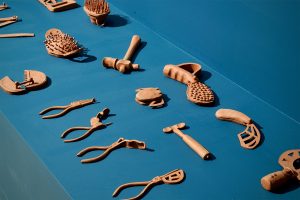May, 2024
202423MayAll Day29JunAND ALL OUR WORLD IS DEW curated by Eva Vaslamatzi(All Day)

Event Details
Organized by The Frances Rich School of Fine and Performing Arts as part of the Arts Festival 2024 Supported by The Art History, Visual Arts
Event Details
Organized by
The Frances Rich School of Fine and Performing Arts as part of the Arts Festival 2024
Supported by
The Art History, Visual Arts and Graphic Design Programs and the Dance Area
Where: Deree – The American College of Greece
ACG Art Gallery, 6 Gravias, Agia Paraskevi
Opening: Thursday 23 May 2024, 18:00-22:00
Performance by Marios Stamatis during the opening – 20:00
Duration: 23 May- 29 June, 2024
Opening hours: Monday- Friday, 15:00-19:00, Saturday, 12:00-16:00
Performance by Yorgia Karidi on Wednesday 12 June – 20:00
The exhibition is free and open to the public
About the exhibition
The group show AND ALL OUR WORLD IS DEW brings together artworks from the ACG art collection selected on the basis of a common interest they exhibit in the natural sciences and mathematical theories, as well as in the systematic observation of natural phenomena and new technologies. The metaphysical dimension of geometry, mathematics, quantum physics or astrophysics is rendered through abstract forms, symmetrical and assymetrical systems, diagrams, drawings, gestures as well as through the use of photographic cameras and photocopiers, motors, dimmers, LEDs and other electrical components. As most of them were made between the 1950s and the 1970s, they also bear witness to the transition from geometric abstraction and kinetic art to using computational intelligence as an artistic medium. Gérard Haas’s handmade electronic masks incorporate the contradictions created as a result of this transition, also present in Edward Meeneley’s electrostatic prints and Liliane Lijn’s kinetic model of the universe.
Dora Iliopoulou-Rogan has noted about Haas’ work that he transforms “cold mechanical computer programs into pulsating, vibrant, imaginative combinations with a poetic zest”. However, he himself saw his practice more as the result of his realizing that the materials he used were “neither cold, nor insensible, nor neutral” but bore a mystical relationship with the human species, which could not be exhausted in their utilitarian value. Traces of the same contradiction can be found in the excerpt of a television interview by the composer and musician Lena Platonos, also figuring among the exhibits. In this interview, given almost a decade after adopting digital sound in her work, Platonos refers to this transition as something that came to her, in her own words, “as naturally as the air I breathe”. The exhibition focuses on these processes and transitions, inextricably linked to technology’s very nature, and highlights new materialities and crafts as well as new ways of encoding that address the machine’s interaction with the most basic human needs.
Οn display are also new commissions as well as other artworks brought in specifically for the exhibition, two of which are actively engaged in conversation with the ACG Collection, as co-curatorial proposals. Natalia Manta retrieves from the collection the old ‘technology’ of the tools used by artists Michael Lekakis and Frances Rich, in order to process their archetypal power through a display-work reminiscent of a pseudo-self-powered oscilloscope system. HYPERCOMF, for their part, make a targeted selection of Haas’s shamanic masks. Τhese masks are placed in conversation with the faceless machines of HYPERCOMF’s embroidery produced on a jacquard loom, which formed the basis for the first programmable machines, and, by extension, today’s computer.
Given the temporal and conceptual distance separating us from the dawn of art’s relationship with technology, contemporary artworks approach—more or less amateurishly—various artificial intelligence programs as interlocutors, testing their limits, highlighting their failures and their uncanniness at a time when the imposition of computer simulation displaces the epistemology of the laboratory experiment. A universal archive of family photographs emerges distorted through Maria Mavropoulou’s quest for childhood memories, while a deliberately wrong instruction in the case of John Smith’s work highlights the Dadaist dimension of an automatic translation software. The images resulting from an amalgam of insect exoskeletons and robotic prosthetics in the work of Marios Stamatis interact with Emre Hüner’s amorphous hybrid materials, mixtures of organic and industrial fragments. The AI images of portals resembling black holes acquire substance in the work of Afroditi Psarras, echoing the transition from the intangible to the material in the painting by Miltos Manetas depicting the post-internet era. Yorgia Karidi, for her part, transports us to a limbo-like situation, a bit before or a little after the end of the world. Τhe arrogance of the machine towards man and nature as well as the inability of Al programs to assume a political stance are the respective locus of concern of ACG students Vaggi Sekifu and Elen Demiryan, also participating in the exhibition.
The exhibition borrows the display cases of the College’s library to showcase archival material from the ACG collection relating to the artists and works on show; as well as some new works, such as texts by Georges Perec or even drafts from the collaboration of ceramist Panos Valsamakis with the Hellenic Telecommunications Organisation (OTE) for the decoration of a central Athens branch facade in the 60s, a unique case of employing one of the world’s most ancient techniques in order to give material substance to the intangibility of telecommunication technology.
As its title —borrowed from a note appearing in Michael Lekakis’s work—suggests, the exhibition showcases the scientifico-poetic observation of the cosmos by the artists. Taking the ever-changing nature of the world’s substance as their only constant, the artworks mirror its paradoxical texture that, much like the natural phenomenon of dew, evokes an otherworldly feeling.
Participating artists: Dimitrios Antonitsis, Irene Baimas-Kiamos, Yannis Bouteas, Katharine T. Carter, Elen Demiryan, Etios, Jean Follett, Emre Hüner, HYPERCOMF x Gérard Haas, Jimmy Hencan, Hans Hinterreiter, Gerald Horn, Yorgia Karidi, Liliane Lijn, Panayotis Linardakis, Natalia Manta x Michalis Lekakis & Frances Rich, Donald Mavros, Maria Mavropoulou, Miltos Manetas, Edward Meneeley, Eva Ohlow, Georges Perec, Lena Platonos, Afroditi Psarra, Vaggi Sekifu, John Smith, Marios Stamatis, Panos Valsamakis
Performances: Marios Stamatis, Yorgia Karidi
Senior Art Collection Manager, American College of Greece: Ioanna Papapavlou
Curatorial Assistants: Dimitra Kostoula, Athina Lasithiotaki, Katerina Milesi, Christina Tsaprailis, Christoforos Vogiatzis (Αrt History and Theatre Arts and Dance Department students, Deree – The American College of Greece)
Graphic Design: Georgios Theodorakakos, Mirka Savvaidi (Graphic Design students, Deree – The American College of Greece)
Graphic Design supervisor: Melina Constantinides (Graphic Design Instructor)
The exhibition is organized by the Frances Rich School of Fine and Performing Arts in the context of the Arts Festival 2024, in collaboration and with the support of the Art History, Visual Arts and the Graphic Design programs, the Dance Area and the ACG Art Collection of Deree – The American College of Greece.
Special thanks to Dr. Katherina Thomas, Niki Kladakis, Dr. Daphne Mourelou of the Dance Area, Dr. Demetra Papaconstantinou, as well as ERT Archives for granting us permission to use Lena Platonos’ interview.
Thanks to Marinos Klouras, Nasia Ntinopoulou, George Papastogiannoudis and Alexis Tsironis for the Marketing and PR of the exhibition, Michalis Orontis and the security team, George Kyrodimos, John Fetalidis, Nassos Sopilis, Victor Zafeiropoulos, as well as Antonis Kontopoulos, Dimitris Fakinos, Stavros Theofilou, Vasilis Palaiogiannis, Manolis Sideris, Stelios Teloniatis, Giannis Gerakellis, John Poulakis, Stavros Karadimitriou, Alekos Potamianos, Giannis Kontopoulos and Takis Moschidis for the technical assistance.

Interview of Lena Platonos, 1987, video still, ERT Archive
Συνέντευξη Λένας Πλάτωνος, 1987, στιγμιότυπο βίντεο, ΑΡΧΕΙΟ ΕΡΤ Α.Ε

Emre Hüner
Exo-Vertebra Drainage Channel Specified, (Psychometrics of the Unfinished series), 2021
Glazed ceramic, iron, paint
Dimensions variable
Courtesy the artist and Rodeo, London / Piraeus
Photo credit: flufoto
Emre Hüner
Exo-Vertebra Drainage Channel Specified, (Psychometrics of the Unfinished series), 2021
Κεραμικά, σίδερο, χρώμα
Μεταβλητές διαστάσεις
Courtesy the artist and Rodeo, London / Piraeus
Photo credit: flufoto

Emre Hüner
Elektuur, 2019
Photo-etching series on paper
42 x 58 x 5 cm
Courtesy the artist and Rodeo, London / Piraeus
Photo credit: flufoto
Emre Hüner
Elektuur, 2019
Σειρά χαρακτικών σε χαρτί
42 x 58 x 5 εκ.
Courtesy the artist and Rodeo, London / Piraeus
Photo credit: flufoto

Maria Mavropoulou
Imagined Images, 2023
Silde projection
Dimensions variable
Courtesy the artist
Μαρία Μαυροπούλου
Imagined Images, 2023
Προβολή σε slide
Μεταβλητές διαστάσεις
Courtesy the artist

Marios Stamatis
EXOEXO, 2020
Video still
Dimensions variable
Courtesy the artist
Μάριος Σταμάτης
EXOEXO, 2020
Στιγμιότυπο βίντεο
Μεταβλητές διαστάσεις
Courtesy the artist

Natalia Manta
Memorial Tools, 2021
Clay
Dimensions variable
Courtesy the artist
Photo credit : by the Korean International Ceramic Biennale team
Ναταλία Μαντά
Memorial Tools, 2021
Πηλός
Μεταβλητές διαστάσεις
Courtesy the artist
Photo credit : by the Korean International Ceramic Biennale team

Miltos Manetas
UNTITLED (Not Internet), 2022
Oil on canvas
133 x 181 cm
© the artist / Courtesy The Breeder, Athens
Μίλτος Μανέτας
UNTITLED (Not Internet), 2022
Λάδι σε καμβά
133 x 181 εκ.
© the artist / Courtesy The Breeder, Athens

Yiannis Bouteas
The Gesture and the Concept #1 ,1973
Silver print on paper
17 x 21 cm.
Courtesy the American College of Greece Art Collection
Γιάννης Μπουτέας
The Gesture and the Concept #1 ,1973
Aργυροτυπία
17 x 21 εκ.
Συλλογή Αμερικανικού Κολλεγίου Ελλάδος

Gerard Haas
#075 Wooden Figure II, 1976
Wood, plexiglass, bakelite
38 x 30.7 x 14.5 cm
Courtesy the American College of Greece Art Collection, Gift of Mme Angeliki Haas
Gerard Haas
#075 Wooden Figure II, 1976
Ξύλο, πλέξιγκλας, βακελίτης
38 x 30.7 x 14.5 εκ.
Συλλογή Αμερικανικού Κολλεγίου Ελλάδος, Δωρεά Mme Angeliki Haas

Gerard Haas
#281 Napoleon III ,1991
Plexiglass, bakelite, steel, LED
24 x 19 x 10 cm
Courtesy the American College of Greece Art Collection, Gift of Dr. John S. Bailey
Gerard Haas
#281 Napoleon III ,1991
Πλέξιγκλας, βακελίτης, χάλυβας, LED
24 x 19 x 10 εκ
Συλλογή Αμερικανικού Κολλεγίου Ελλάδος, Δωρεά Dr. John S. Bailey

Liliane Lijn
Liquid Reflections, 1968
Perspex, metal, water, liquid paraffin, motor, electrical components and lamp
Diameter: 86 cm
Courtesy the American College of Greece Art Collection
Liliane Lijn
Liquid Reflections, 1968
Perspex, μέταλλο, νερό, υγρή παραφίνη, κινητήρας, ηλεκτρικά εξαρτήματα και λάμπα
Διάμετρος : 86 εκ.
Συλλογή Αμερικανικού Κολλεγίου Ελλάδος

Donald Mavros
Design for Pottery #9, ca.1960
Pencil and ink on paper
30.5 x 41.4 cm
Courtesy the American College of Greece Art Collection, Mr. Takis Efstathiou
Donald Mavros
Design for Pottery #9, ca.1960
Μολύβι και μελάνι σε χαρτί
30.5 x 41.4 εκ.
Συλλογή Αμερικανικού Κολλεγίου Ελλάδος, Δωρεά Τάκη Ευσταθίου
